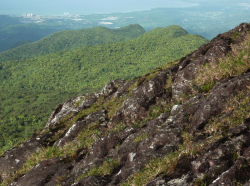El Yunque rock, an icon of Puerto Rico, is eroding more slowly than expected, geologists discover

(Phys.org)—El Yunque rock is a majestic, anvil-shaped promontory that has been an icon of the island of Puerto Rico since pre-Columbian times. The barren rock, standing 3,412 feet high, protrudes above primary old growth forest and is enshrouded in clouds, swept constantly by the trade winds and frequently stricken by hurricanes. The rock receives an average of three rain showers a day and more than 14 feet of rain every year. Given Puerto Rico's warm and dynamic tropical climate, El Yunque should be covered with vegetation and eroding rapidly. Yet the rock appears to have escaped this geological fate.
To understand how erosion has affected the rock and surrounding mountains, a research team from the University of Pennsylvania and the National Science Foundation-supported Luquillo Critical Zone Observatory led by Jane Willenbring, Gilles Brocard and Frederick Scatena sought to quantify the current rate of erosion and to employ a new approach to calculate how the rate has changed through time.
All affiliated with Penn's Department of Earth and Environmental Science in the School of Arts and Sciences, Willenbring is an assistant professor, Brocard is a postdoctoral researcher and Scatena is professor and chair.
The new method involves counting the isotopes that are produced and accumulate in rocks when they are hit by cosmic rays. By counting these isotopes, known as cosmogenic nuclides, the researchers confirmed that forest soils that are not disturbed by human activity erode at rates of 250 to 500 feet per million years. Using this rate, the team calculated that undisturbed forested areas have eroded approximately 1.6 to 3.2 inches since Europeans first landed on the island in 1498.
These erosion rates are slow compared to most tropical mountains and are orders of magnitude lower than rates from areas disturbed by human activity. In addition, the researchers found that forest cover can greatly reduce erosion, even in a steep tropical environment with frequent hurricanes and soils high in clay.
These cosmogenic techniques also allowed the research team to make the first measurements of the erosion rate of the area at El Yunque's peak. They discovered that the barren surface of the peak is eroding at a rate of just 13 feet per million years. At this rate, the rock has only lost 0.08 inches of its height since Europeans first arrived. The prominent rock's relatively slow rate of erosion explains why it juts out above the surrounding landscape and lacks the soil needed to support forest vegetation.
The texture and composition of the rocks that form El Yunque are more erosion-resistant than the surrounding landscape, the researchers found, because of their hardness and their chemical properties obtained from being "cooked" in the chamber of an ancient volcano. Most of the other rocks that make up the Luquillo Mountains were not subject to this same type of heating and are less resistant to chemical breakdown and erosion. Thus the island's icon is literally a hard-headed cap that provides stability to the region.
Provided by University of Pennsylvania



















